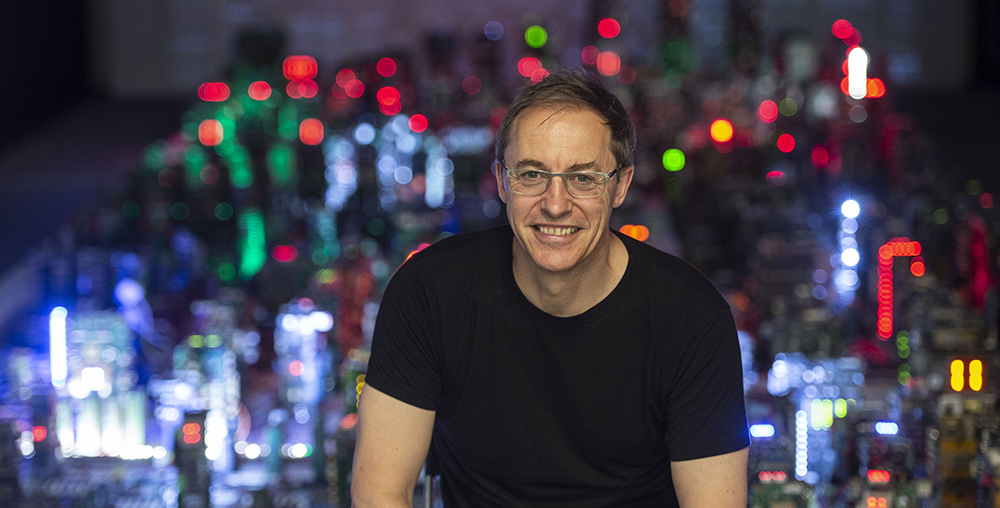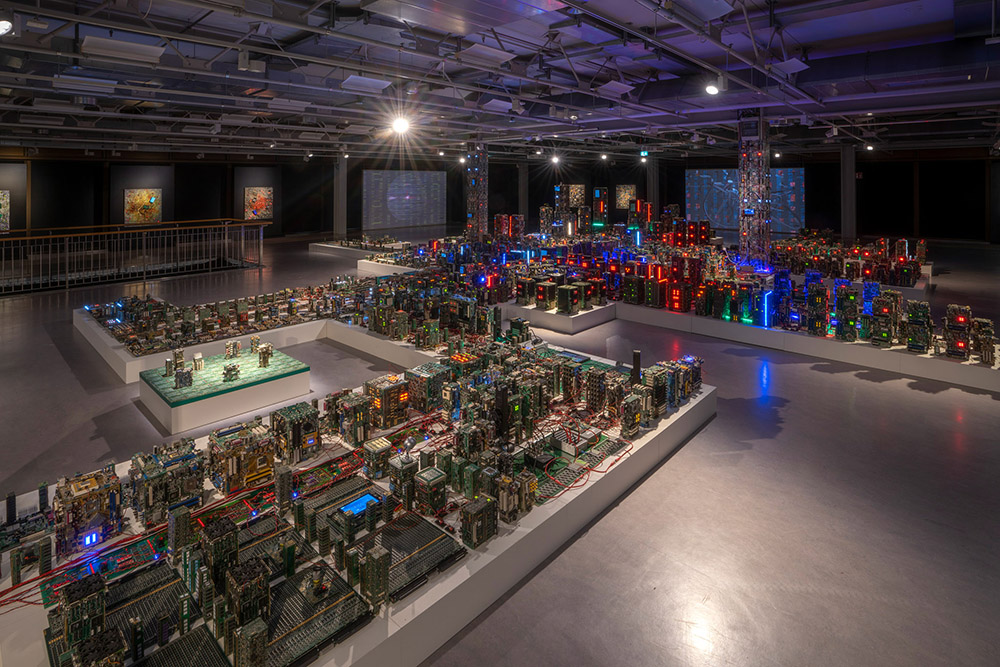


Artistic Practice
Dr Stanza is an independent artist based in London who has been exhibiting worldwide since 1982. His work lives at the intersection of art and potential futures of disruptive and opportunistic nature, delving into scenarios of observation, invisible agency, and the changing human environment. The artworks demonstrate how humans are complicit and thus entangled in the surveyed and monitored technological layers they communicate. They fit seamlessly into what he calls 'panoptic aesthetics'. The technologies incorporated in his digital artworks can include, custom-made sensors, networked cameras, robotics, and computers. What becomes real are the art installations, sculptures, websites, software systems, and paintings Stanza exhibits. Stanza's artworks have won twenty international art prizes and art awards including:- Vidalife 6.0 First Prize Spain. SeNef Grand Prix Korea. Videobrasil First Prize Brazil. Cynet Art First Prize Germany. Share First Prize Winner Italy. Video Formes France. Next Nature Prize.
His art has also been rewarded with a prestigious Starts Residency, Nesta Dreamtime Award, an Arts Humanities Creative Fellowship a Clarks bursary, and numerous international arts residencies.
His artworks have been exhibited in over one hundred exhibitions globally including- Venice Biennale Italy: Deutsches Museum Germany: Victoria Albert Museum: Tate Britain: Rijksmuseum Twente: HNF Germany: Bruges Museum Belgium: Fundacion Telefonica in Spain: TSSK Norway: Museo Tamayo Arte Contemporáneo Mexico: Plymouth Arts Centre UK: ICA London UK: State Museum, Novosibirsk: Biennale of Sydney: Sao Paulo Biennale: De Markten Brussels: Museum Of Cyptography Moscow: Transport Museum London: Haifa Museum: QUAD Derby UK: FACT Liverpool UK: Ars Nova Museum Finland: York Art Gallery: Salisbury Cathedral: Centre des Arts Les Bain France: Bury Art Museum, UK: Kellen Gallery USA: Samek Art Museum USA: Shrewsbury Museum UK: Samsung Media Centre Korea: Heinz Nixdorf Museum Germany: Järvenpää Art Museum: Multimedia Art Museum Moscow: Quays Culture, Wolverhampton Art Gallery: The Open Data Institute: The Goodwood Festival Of Speed: The Lowry: Mundo Urbano Spain:
His most recent work connects data streams from ‘Smart Cities’ speculating on ideas for merging various types of data using methods of artificial intelligence AI and ML learning to create new artistic scenarios. The thrust of these artworks aims to show what happens when the public is allowed to make their own mixes and visualisations with the data, reclaiming ownership and representing data in new and different ways. Stanza transforms abstract data into dynamic, living artworks. These pieces reflect the complexities of surveillance culture, raising questions about agency, control, and the ethical dimensions of our connected existence. His concept of panoptic aesthetics describes this merging of data systems with visual culture—where technology not only observes but becomes part of the artwork itself. Projects like The Nemesis Machine imagine the city as a self-governing entity, powered by the very data it produces. In this vision, the artwork becomes a responsive ecosystem—an expressive, evolving map of urban behaviour.
Some of his most well known digital art projects include:-
Stanza was one of the first artists to use the internet as an art medium. His major online internet projects include the Net Art archive with work from 1995, soundcities.com (a global soundmap project 1997-2024), Genomixer.com DNA-based artworks 2000-4), thecentralcity.co.uk (urban and city systems 1996), amorphoscapes.co.uk (generative painting 1997-2007), and soundtoys.net (an online curated art portal 1996 + now offline).
VIDEO CHANNELS.
Amorphoscapes Channel code based paintings. They were all made as online interactive systems ie net art and some have been editioned as touch screens and made as executable software. (1997-2007) There are over sixty videos.
Net Art Channel: (1995-2009 )Videos of artworks specifically made for the internet as generative net art online works. These are user-based experiences and custom-made software and have been exhibited at many museums around the world, from 1995 onwards. There are over fifty videos here.
Panic Noise Videos 1985. Created using analogue VT technologies and early computer graphics systems including BBC micro, Amiga and Quantel Paintbox. These artworks uses patterns and forms from the city. There are over one hundred.
Dr Stanza AKA Steve Tanza (PhD, MA, BA, Cert Ed, PG Dip)
studied art at Goldsmiths College University of London, Greenwich University, Central Saint Martins and University Of Westminster London. Stanza was also an AHRC arts research fellow at Goldsmiths College.

EMAIL STANZA@SUBLIME.NET


Portrait of the artist Stanza. Hi res here.

Artworks produced trace an interest in the city metropolis from the linear city (paintings music video) to the interactive city (software, websites, touch screens), the generative city (installations, software), the emergent city (installations, sculptures, software), to entangled cities (AI, installation, software, data)
STANZA INTERESTS
Stanza focuses on the landscape of monitored and networked real-time information flows, and the artworks created reflect this. Underpinning his artworks are a whole series of potential problems about observation, invisible agency, and the ethics of the control space. His digital artworks are experienced as fused mashed-up data cities and real-time performative city experiences, all re-presented online as systems of control and systems that demonstrate how these systems control. Furthermore the artwork demonstrates how we are complicit and thus entangled in the surveyed and monitored technological layers that the artworks are communicating and fit seamlessly into what he calls panoptic aesthetics. What becomes real are the art installations, sculptures, and paintings Stanza exhibits.
The work asks how new technologies can imagine a world where we as citizens are liberated and empowered by using new technologies in an inclusive, connected, collaborative, and shared experience. The artwork merges online virtual data layers to create a Third Space, enabling new possibilities in the virtual world of shared data. This leads to new questions and new economic possibilities, and a new perspective on understanding the world around us.
This city governs itself and its actions, and the intelligence is completely controlled by the data interactions of the system. For example the different ‘districts’ of the artwork The Nemesis Machine act as a frame for the different expressions of data which in effect make up a connected city.
Dataveillance and Panoptic Aesthetics.
Can we use new technologies to imagine a world where we are liberated and empowered, where finally all of the technology becomes more than a gimmick and starts to actually work for us or are these technologies going to control us, separate us, divide us, create more borders?
Imagine walking out the door, and knowing every single action, movement, sound, micro movement, pulse, and thread of information is being tracked, monitored, stored, analysed, interpreted and logged. Selected artworks explore these concepts relating to the behaviours, activities, and changing information of the world around us using my networked devices and information across the internet.
As individuals we have been reduced to bits of code. We are either zeros or ones in the global information system. The whole world is penned in by algorithmic functions from corporate systems like Amazon, Google and Facebook, to a newer total surveillance system in China that tracks everything as a social status system ranking people for all to see completely on stage and in public. Whether by design, intention or desire, we have nonetheless brought ourselves to this position by our own agency.
The Stanza website has many artworks representing data in new and different ways. The purpose is to put the user in control of the data, creating a public engagement artwork within urban space, and to create a new artistic context where such collaborations might lead to a new understanding of the shared networked technological landscape and our future relationship to it. Thus the process of engagement allows one to once again become aware of one\’s actions in the system and the complicit and entangled nature of this behaviour.
Recent work has responded to the shift into what commentators are calling liquid surveillance. This involves looking at the flows of data streams from for example city wide monitoring technologies that are now parsing data and making it available in the virtual worlds as other much larger systems.
We are witnessing the convergent worlds of machine learning and AI which interpret these data which I believe are pointing to differing visions for the spaces we live in (monitored by technology). Can we build autonomous machines whose data input forms a separate ‘consciousness’. Can we make a city that lives by itself (self governing) or a robot /sculpture that acts on a post truth narrative (makes its own decisions). The aim is to build an interrogative system that learns from itself based on the idea of total world control, in order to test ethical accountability. In other words what happens if we build a system of control and privileged ownership?
How will AI affect the governance of the city of the future and how will this be manifested as artworks an audience can experience?
https://www.stanza.co.uk

|